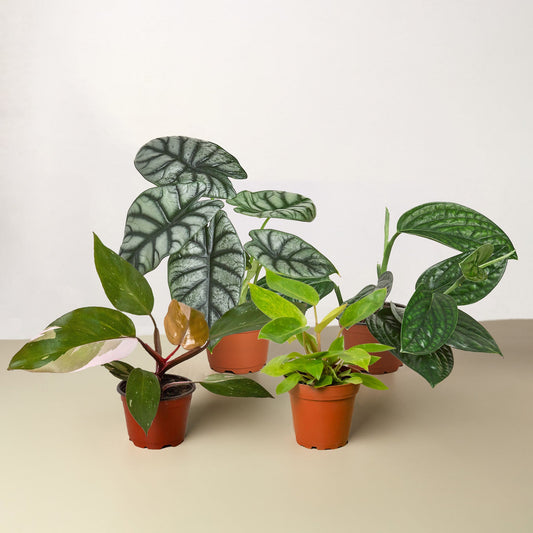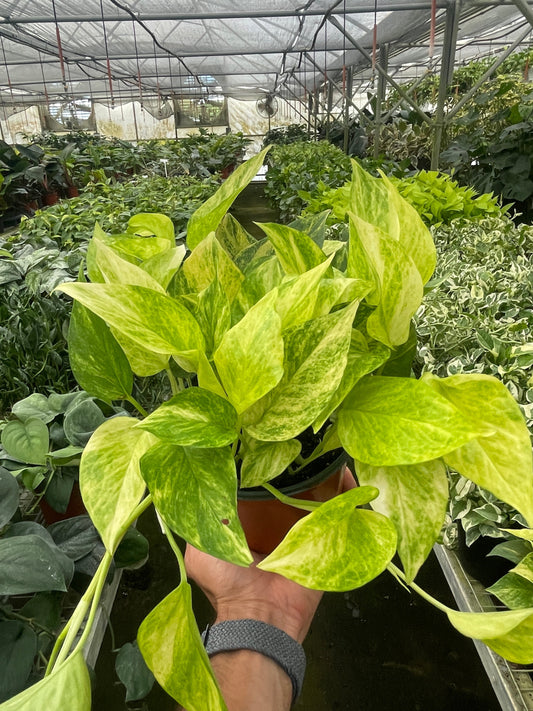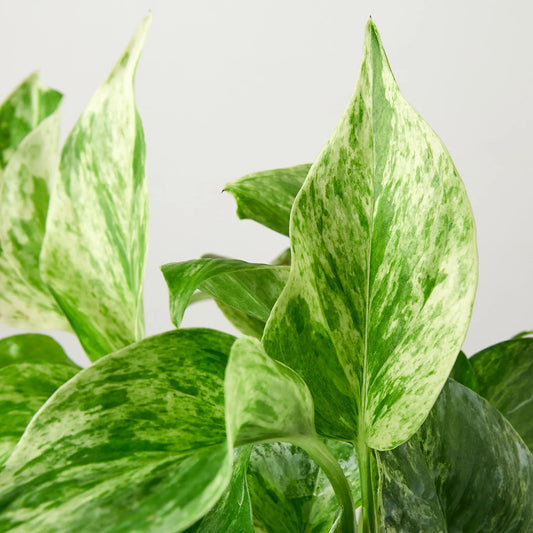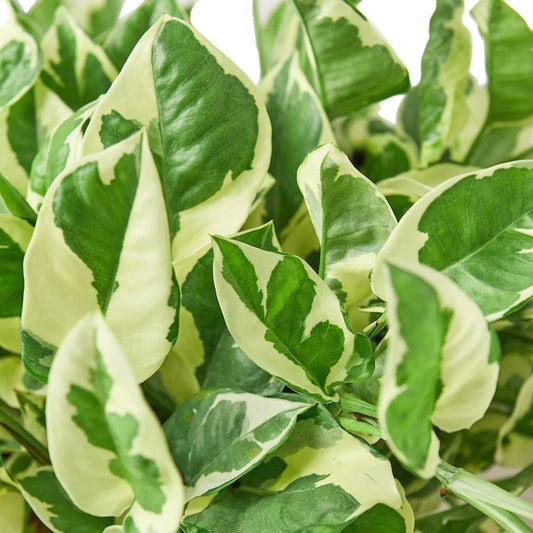Gold Star Dracaena Rust Fungus (And What To Do About It)
Cafe Planta Team
Gold Star Dracaena is a popular houseplant with its striking foliage and easy care routine. However, like many plants, it can fall prey to various issues, with rust fungus being a common culprit. If you've noticed those pesky orange spots on your plant's leaves, you're not alone. Rust fungus is a manageable problem, and today, we'll explore how to identify, treat, and prevent it.
In this post, we'll go through the signs of rust fungus, why it occurs, and the steps you can take to restore your Gold Star Dracaena to its full glory. We'll also touch on preventative measures to keep your plant healthy in the long run. So, grab a cup of coffee, and let's tackle this plant problem together!
What is Rust Fungus?
Rust fungus is a plant disease caused by a variety of fungal species. It's called "rust" because of the characteristic orange, yellow, or brown spots it leaves on the foliage. These spots are actually pustules containing fungal spores, which can easily spread to other parts of the plant or even neighboring plants if not addressed.
These fungi thrive in warm, humid environments, making indoor plants like the Gold Star Dracaena particularly susceptible. While rust fungus doesn't usually kill plants outright, it can weaken them, making them more susceptible to other diseases and pests.
It's crucial to catch rust fungus early. The earlier you identify and treat it, the better your chances of preventing significant damage. Keep a watchful eye on your plant's leaves for any unusual discoloration or spots.
Identifying Rust Fungus on Your Dracaena
Identifying rust fungus can sometimes be tricky, especially if you're new to plant care. Here's a simple checklist to help you spot the signs:
- Color Spots: Look for small, circular spots that are orange, yellow, or reddish-brown. These are often found on the underside of the leaves.
- Texture Changes: The affected areas may feel slightly raised or bumpy due to the pustules.
- Leaf Discoloration: Over time, the entire leaf may turn yellow or brown as the fungus spreads.
- Leaf Drop: In severe cases, leaves may wilt and drop off the plant.
If you notice any of these symptoms, it's time to take action. The sooner you address the problem, the easier it will be to manage.
Why Does Rust Fungus Occur?
Understanding why rust fungus occurs can help in preventing future outbreaks. Here are some common reasons your Gold Star Dracaena might be affected:
- Humidity: High humidity levels create a perfect breeding ground for rust fungus. Indoor environments with poor air circulation exacerbate this issue.
- Watering Practices: Overwatering or allowing water to sit on the leaves can encourage fungal growth. It's essential to water at the base of the plant and avoid wetting the foliage.
- Temperature Fluctuations: Sudden changes in temperature can stress plants, making them more vulnerable to diseases.
- Proximity to Infected Plants: Rust spores can easily travel from one plant to another, so if you have other plants with similar issues, your Dracaena might be at risk.
By adjusting your plant care routine, you can reduce these risk factors and help prevent rust fungus from taking hold.
Treating Rust Fungus on Gold Star Dracaena
Once you've identified rust fungus on your Dracaena, it's time to act. Treating it involves a combination of physical removal, chemical treatments, and environmental adjustments. Here's a step-by-step guide to help you through the process:
Step 1: Physical Removal
Start by removing any heavily infected leaves. Use clean, sharp scissors or pruning shears to cut them away, making sure to dispose of them properly. This helps prevent the spread of spores to healthy parts of the plant.
Step 2: Apply Fungicide
There are various fungicides available, both chemical and organic, that can help control rust fungus. Here are some options:
- Copper-based fungicides: Effective against many fungal diseases, including rust. Follow the instructions on the label for application.
- Neem oil: A natural, organic option that can help manage fungal growth. Dilute according to the label and spray the affected areas.
- Baking soda solution: Mix one tablespoon of baking soda with a quart of water and a few drops of dish soap. Spray on the affected leaves every few days.
It's important to reapply treatments as directed, as fungi can be persistent. Consistency is key in controlling the spread.
Step 3: Improve Air Circulation
Improving air circulation can inhibit fungal growth. Consider repositioning your plant to a spot with better airflow or using a small fan to promote movement around the plant.
Step 4: Adjust Watering Practices
Ensure you're watering your Dracaena properly. Water at the base and avoid getting the foliage wet. Allow the top inch of soil to dry out between waterings to prevent moisture-related problems.
Preventing Future Rust Fungus Outbreaks
Prevention is always better than cure, especially when it comes to plant care. Here are some preventive measures to keep your Gold Star Dracaena healthy and rust-free:
Maintain Ideal Conditions
Gold Star Dracaenas thrive in moderate humidity and bright, indirect light. By maintaining these conditions, you reduce the risk of fungal infections:
- Keep the plant in a well-lit area, but out of direct sunlight.
- Use a humidity tray or mist the plant occasionally to maintain moderate humidity without overdoing it.
Regular Inspection
Make a habit of inspecting your plants regularly. Look for early signs of rust fungus or any other issues. Catching problems early makes them easier to manage.
Quarantine New Plants
Whenever you bring a new plant home, keep it separate from your existing collection for a few weeks. This reduces the risk of introducing any pests or diseases to your other plants.
Sanitize Tools and Equipment
After handling infected plants, make sure to clean your gardening tools thoroughly. This prevents the transfer of spores to other plants.
Integrating Dracaena into Your Home Design
Beyond care, Dracaenas are excellent for home decor, offering vibrant green foliage that can brighten any room. Here's how you can incorporate them stylishly:
Choosing the Right Spot
Dracaenas love bright, indirect light, so placing them near a window where they can soak up the sun without direct exposure is perfect. Consider these spots:
- Near a north or east-facing window for natural, gentle light.
- As an accent piece in a living room corner.
- In a hallway to add greenery and interest.
Pot Selection
Your plant's pot can make a statement. Choose something that complements your decor style:
- A sleek, modern pot for minimalist decor.
- A rustic, terracotta pot for a more natural, earthy vibe.
- Decorative ceramic pots for a splash of color or pattern.
Group with Other Plants
Dracaenas pair well with other houseplants, creating a lush, tropical feel. Try grouping them with:
- Ferns for a textural contrast.
- Snake plants for varied heights and structure.
- Pothos for a cascading effect.
This not only enhances the visual appeal but also creates a healthier environment by improving air quality.
Common Mistakes in Dracaena Care
Even seasoned plant parents can make mistakes, and that's okay. Let's go over some common pitfalls and how to avoid them:
Overwatering
Overwatering is a frequent issue. Dracaenas prefer to dry out a bit between waterings. Remember to check the top inch of soil before adding more water. If it's still moist, give it a little more time.
Ignoring Light Needs
While Dracaenas are adaptable, they do best in bright, indirect light. Too little light can lead to leggy growth, while too much direct sunlight can scorch their leaves.
Neglecting Pest Control
Though they're generally pest-resistant, Dracaenas can occasionally attract pests like spider mites and mealybugs. Regularly inspect your plant, and if you see any signs of pests, treat them promptly with insecticidal soap or neem oil.
Pot Bound Roots
Dracaenas don't mind being a bit root-bound, but if you notice roots growing out of the drainage holes, it might be time to repot. Choose a pot that's one size larger to give the roots room to grow.
Reversing Rust Fungus Damage
If your Dracaena has suffered significant damage from rust fungus, don't worry—there's hope. Here's how you can nurse it back to health:
Prune Affected Areas
Be bold about pruning away heavily infected areas. This will help the plant direct energy towards new, healthy growth.
Boost Nutrition
Consider using a balanced houseplant fertilizer to give your Dracaena a nutritional boost. Follow the instructions on the package for the best results.
- Use a liquid fertilizer for even distribution.
- Apply during the growing season (spring and summer) every 4-6 weeks.
Maintain Consistent Care
Stick to a consistent care routine to help your plant recover. Regular watering, adequate light, and proper humidity levels will encourage new growth.
With time and patience, your Dracaena will bounce back, vibrant and healthy once more.
Final Thoughts
Dealing with rust fungus on your Gold Star Dracaena can be a challenge, but with the right knowledge and care, it's entirely manageable. By understanding the causes, implementing treatment, and taking preventive measures, you can ensure your plant remains healthy and vibrant.
At Cafe Planta, we're passionate about helping plant lovers nurture their green companions. We offer a wide range of plants and accessories to aid in your plant care journey. If you have any questions or need guidance, feel free to email us or reach out on Instagram. We're here to support you in creating a thriving plant collection in your home.



















